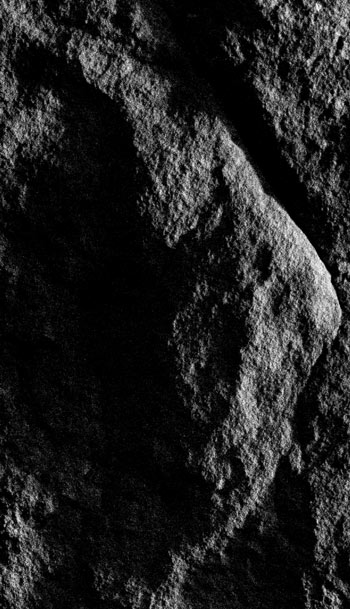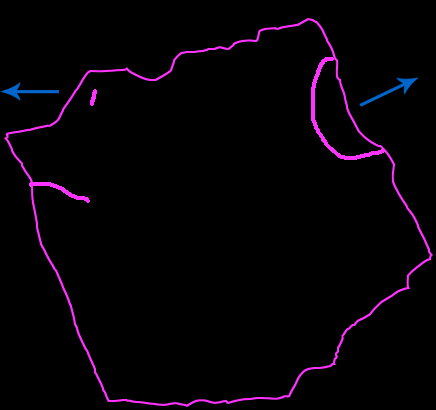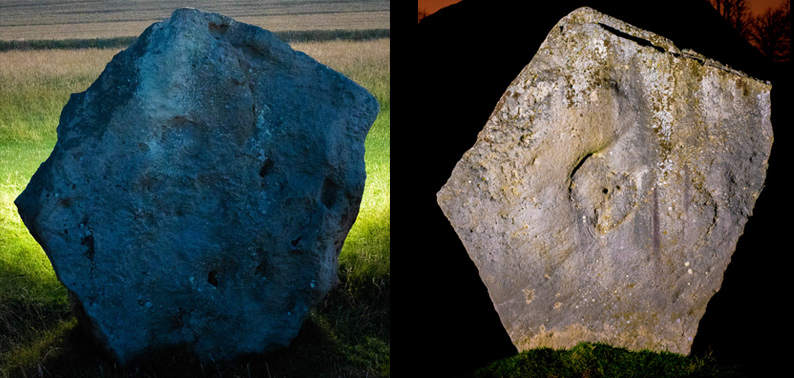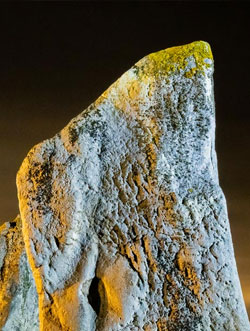|
Avebury Project - Original Archaeological Discoveries I have made

Headline - My nights at Avebury have shown me many new things, but the 3 discoveries I am most proud of are:
(i) the presence of ultra rare pick-dressing on Stone 26b, West Kennet Avenue click here for details
(ii) the finding of the beautiful, haunting and elusive horned face on Cove Stone I click here and here for details
(iii) my realisation that the classic Avebury diamond stones were in fact intended to display a specific religious "dual symbol" comprising left and right profile carved faces click here for details
My motivation in starting this Avebury project was artistic, not archaeological. However, Avebury hasn't been photographed much at night, and it seems to me that night lights can reveal details in the stones which are much harder to see in the daytime. Imagine my surprise then when I began to notice previously undiscovered features in my night photographs, particularly in relation to the faces in the stones. I checked my books to confirm that what I had seen was not previously recorded or understood, and that I had therefore discovered something new.
In claiming discoveries I need to be careful. Let me start by saying what details I haven't discovered for myself in this photo project:
A. The commonly and easily recognised faces in the stones, for example the "shark" face on West Kennet Stone 35a, or the same Avenue's Stone 37b which is a horse. Everyone can see those and many others like them!
B. The many more faces discovered by Professor Meaden and Di Pattison (for the record I possessed the Meaden book very early in my project, and the Pattison book from mid-September 2020). If I photograph any details that I am aware were specifically discovered and shown photographically in either of these respective books I will expressly acknowledge this, or else refer to their work using the "compare with" Cf abbreviation.
What have I discovered then in my photographs on this website? Amongst other things:
1. That the difficult to interpret Stone 50 of the henge's north-east quadrant is in fact a beautiful relief of a bull. I achieved this by finding the small and very elusive eye slit on the left hand side of the monolith, a finding made possible by using highly directional light at night:

2. That the eye slit used on Stone 50 is a simple device also used to make a face on the famous Swindon/Diamond Stone (see also point 25 below):

3. That in the henge's north-east quadrant the famous Cove Stone II and Stone 201 in fact represent the same or symbolically closely related Neolithic character:

4. While I am sure I am not the first person to see the face on Stone 5, I am the first person to point out the two reasons it is such significant stone. a) Some archaeologists deny that the Avebury stones were sculpted at all, Stone 5 is therefore particularly important as it is without any doubt whatsoever a carving, clearly artificial. Although it is a crude carving by Avebury standards, it does show how the ancestors set up raw sarsen stones, and then edited them to show characters. b) Gruesomely I suggest that the stone may well represent a dead face in the process of excarnation, presumably by birds:

5. That many of the sculptures distinctively show only half a character's face, or the edge of a face apparently turned away from the viewer, leaving the missing/turned away portion enigmatic.
This is not an omission on the artists' part but a style, showing animated life in the process of emerging from the primordial background of the stones:
 
6. That the star-gazer style of carving at Avebury derives from an original at West Kennet Long Barrow:
 
Furthermore I divide the star-gazers into two categories, those that stare straight up (the zenith-seekers) and those that appear to stare upwards but at an angle to the south where the celestial equator crosses the meridian (the equator-seekers).
Examples of zenith-seekers include West Kennet Long Barrow's Facade Stone 02, West Kennet Avenue's Stone 33b and the Henge's south-east quadrant Stone 01. Examples of equator-seekers include West Kennet Avenue's Stones 29a, 33a and 35b. The Avenue has an interesting possible variant or sub-variant of the normal equator-seeker - Stone 36a. This monolith, when viewed from the east, appears to look in the expected southerly direction, but its distinctive crescent shaped face might suggest it was particularly intended to watch the culmination of the moon?
7. I have discovered the existence of two zenith-gazing faces atop the southern face of Stone 1 of the south east quadrant. I suggest that one face represents death in the form of a skull, and the other represents a living face. This echoes symbolism others have found in carvings at West Kennet Long Barrow, symbols of the life/death cycle overseen by the Great Goddess:

8. A wonderful trio of east looking faces on the Beckhampton Cove Stone:

9. A particularly beautiful stylized face on the last remaining stone of the Beckhampton Avenue. To me this is easily one of the best faces at Avebury:

10. That the Beckhampton Cove Stone contains recursive "faces within faces":

Now that I have recognized this device I am spotting examples of recursive faces all over Avebury.
11. A highly significant giant east looking faceon the south side of the Swindon Diamond Stone (see also point 25 below):

12. I suggest that Stone 102 hosts a large image of a skull. This eastward looking face could be seen to be concerned with death and rebirth, a dead head looking hopefully to the rising sun to create new life/resurrection? As can be seen in point 17 below, I believe the monolith also hosts a carving of a hare, a living fertility symbol, nicely balancing the skull symbol of death. Life and death contrasted:

13. I have discovered an amazing zenith-seeking face on top of the famous Cove Stone II, proving that such star-gazing carvings were not just peripheral, limited to the Long Barrows and Avenues, but represent crucially important imagery deserving a place at the very heart of the main henge, central to the sky worshipping ceremonies that occurred there:

14. Strange faint right profile faces on Stone 36a, West Kennet Avenue:

15. A beautiful sculpture of an animal's face, at least 5600 years old at West Kennet Long Barrow:

16. As well as documenting the existence of two different classes of human faced zenith-seeking statues (here) I have also identified a splendid animal faced zenith-seeker:

17. I have discovered that Stone 102 and 103 represent Hares "walking" in a circle around the now vanished Obelisk stone:
18. I have identified a surprisingly intimately scaled triangular zenith-seeking face atop WKA Stone 25b:

19. A zenith-seeking ewe's face atop the South-west quadrant's Stone 7 (compare this face with that in point 15 above):

20. Haunting left facing profile on the Hag Stone, carved with enormous attention to detail:

21. A stylised benign portrait of a chief/priest with beard and headband, carved on top of Stone 98, South-East Quadrant:

22. A meandering natural cleft in the rock deliberately worked up into a likeness of a man (possibly wearing a hood or leather cap), all to be found on Stone 10, South-West Quadrant:

This likeness possibly has a very similar twin on nearby Stone 7 (click here and scroll down to view Stone 7's face No.3 to see what I mean).
23. This beautiful songbird on Stone 98:

24. Surprised to discover this haunting horned/beaked face on Cove Stone I. I have never seen this face referenced in any of the books, and so I believe it is an original discovery by me. If this face were easier to find I suspect it would have been aggressively smashed by medieval Christians because they would have misinterpreted it as demonic. Luckily for us the carving escaped their notice and survived, to me it is the finest neolithic artwork I have ever seen - eerie, ethereal and elusive.

25. I believe that Avebury's builders worshipped 2 gods which appear in stylised form all over the sacred site. One god had a beaked/pointy face (see point 24 above), the other was a flat faced/blocky god depicted on many of the zenith-seeking carvings at Avebury.
Below is a diagram showing where to find good examples of both the beaked and flat faced gods which were carved on opposite corners of the Swindon Stone, each face respectively looking west and eastwards (click here for more information):

26. I also believe that the many lesser quality flat-faced blocky faces
that appear all over Avebury are in fact simplified versions of the artistically more accomplished masculine faces shown on West
Kennet's Stones 26a and 31a. Both these faces sport (leather?) caps, and 26a has the same distinctive eye panel as the massive face on the massive Swindon Diamond stone (visible here).
27. That the exact same design was used on two different monoliths in completely separate Avebury locations (click here and scroll down for details):

28. A magnificent eastern sky-gazing carved hare atop the ceremonially crucial Cove Stone I:

29. That the iconic Barber's Stone hosts a beautiful bovine head:

|